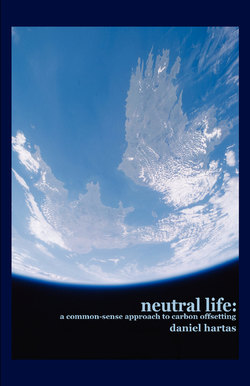Читать книгу Neutral Life: - John Hartas - Страница 6
На сайте Литреса книга снята с продажи.
Office Supplies, Appliances and Products
ОглавлениеCalculating the carbon cost of items purchased can be extremely complicated. Even within individual products, there can be significant variation: presumably based on varying production techniques, transport distances, and scopes of study. A reasonably full list of carbon costs of items can be found at www.co2list.org/files/carbon.htm, though the figures given are rules of thumb. A case study on the carbon cost of a ream of paper revealed very quickly why there is a problem.
The CO2list website lists the carbon cost of 88 sheets of paper as 1 lbCO2e, which works out as around 2.6kg per ream. Published information from paper companies on the carbon cost of their product is scarce, but one provider of carbon neutral paper claimed to offset 959 kilos per tonne of paper [Ref. 12], working out as 2.4kg per ream, a significant distinction considering the bulk in which paper is produced.
To confuse the issue further, another company specialising in paperless business gives a much higher cost on its website: 8.4kg for one ream, before transportation and shipping [Ref. 13]. Their method of calculation makes clear why their value is so much higher: they assume that a tree would have been left where it was had it not been used to make paper, and that no tree will be planted in its place. Their figure for the cost of the industrial part of making a ream of paper is 2.95kg: still larger than other figures, even before including transport, but now on a closer order of magnitude. They claim that only 30% of paper wood comes from managed forests: if this is taken into account, their figure may be closer to the truth, though it is probably a safe assumption that the carbon neutral paper has been sourced sustainably.
This highlights one of the biggest difficulties in defining a carbon footprint: how to define the scope of an individual or organisation’s impact. Even if it were easy to discover the carbon cost of purchased items, do you account for all the carbon costs of the supplier during production? The supplier’s supplier? The chain could go back indefinitely, or at least until you were accounting for the emissions cost of some small fraction of all agents in the economy.
It is possible to deal with this problem by contacting suppliers of purchased items individually and asking them for details on the emissions cost of their products, or even less accurately by using rules of thumb such as those found on CO2list. The prevailing view seems to be the pragmatic one: that those with the most direct information should be responsible for calculating the emissions.
In offsetting carbon, a line must be drawn somewhere, and most emissions cost calculations draw that line at direct responsibility – those emissions which an individual or organisation could potentially stop altogether. However, this is a moral question with no clear answer: it must fall to the conscience of the individual or organisation choosing to offset their carbon.
